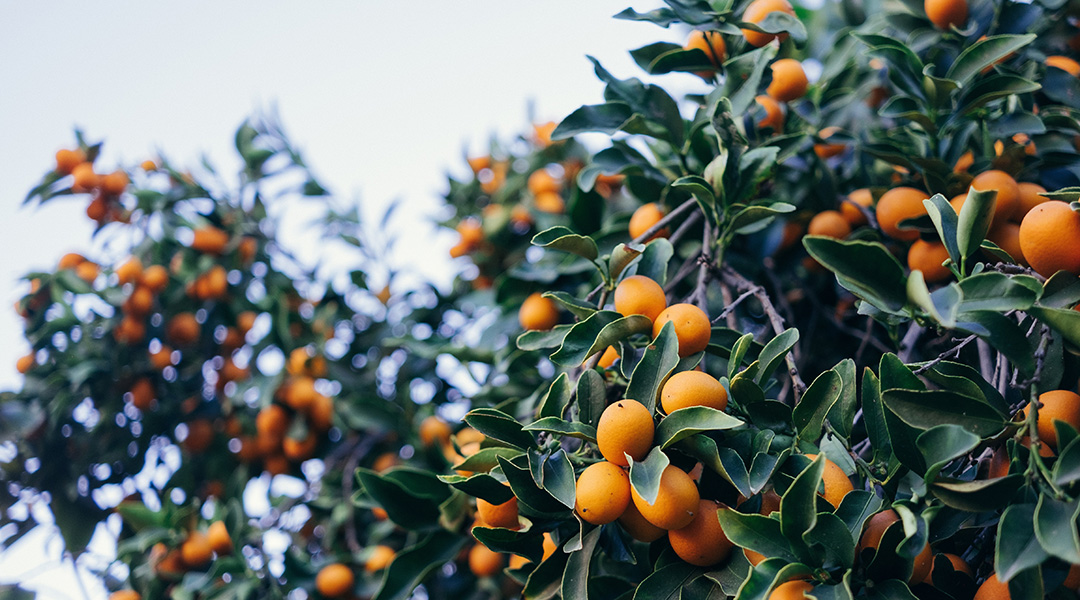Citrus orchards are increasingly infected by citrus canker, a highly contagious disease that causes lumpy brown lesions on leaves and fruit of orange trees. A plant-based antibacterial delivered by tiny technology may offer a new way to control this tricky disease.
“Citrus canker is a symptom-localized disease, difficult to eradicate, and once established into a citrus plot takes years of management to control,” explained Alberto Gochez, a citrus pathology researcher at the Citrus Phytopathology Laboratory INTA Bella Vista in Argentina. “For that reason, the monitoring and early management of the disease is important.”
Caused by the bacterium Xanthomonas citri, the disease is spread by wind and rain, and although infected fruits are not harmful to humans, transporting them for sale might spread the disease to other regions. By 2024, citrus canker is projected to infect half of the world’s citrus orchards.
Current treatments use copper, which kills bacteria and has been used for centuries to protect plants from pathogens. Unfortunately, with prolonged use copper accumulates in the environment and can decrease soil biodiversity and harm water quality. It may also be linked to Alzheimer’s disease. Alternative methods to treat and prevent further spread are urgently needed.
A microgel solution
A team of researchers have devised a remarkable solution: nano-sized microgel “sponges” filled with a plant-based antibacterial that stick to orange tree leaves with infinitesimally small grappling hooks.
Ulrich Schwaneberg and Andrij Pich, professors at the DWI–Leibniz Institute for Interactive Materials in Germany, and Henrique Ferreira, associate professor of bacterial genetics at the State University of Sao Paulo in Brazil, and their co-workers collaborated on the project reported in Advanced Functional Materials.
The microgels’ ability to stick to plant leaves allows them to slowly release the antibacterial directly where it is needed, providing targeted, long-term protection for the trees. “[This technology] exhibits lower toxicity to the environment and constitutes an excellent platform for the controlled release of plant defensives as well as nutrients,” said Schwaneberg.
The antibacterial compound, hexyl gallate, is a derivative of gallic acid, which is found in plants such as tea leaves and grapes. The researchers had previously found that it effectively inhibited growth of X. citri in two ways: by poking holes in its membrane and by preventing its cells from dividing.
However, delivering it to plants is tricky because it does not stick to leaves well. “We needed a platform to deliver the compounds safely, to make sure they got fixated on the plant parts,” said Ferreira.
The 3D microgels help solve this problem as they shrink and swell in response to environmental cues, such as pH and temperature, and they can carry a lot of the antibacterial agent — up to 40% of their own weight. The researchers decorated them with anchor peptides, like tiny grappling hooks, which help them cling to the waxy coating of orange tree leaves so they are not washed off in the rain.
Effective protection against citrus canker
After testing that the microgels could both hold and then release the antibacterial and that they would reliably stick to plant leaves, it was time to test how the loaded microgels performed in the greenhouse compared to a commercial copper-based treatment.
The researchers sprayed sweet orange trees with hexyl gallate-loaded microgels or the copper-based treatment and then infected them with X. citri. Untreated plants developed about 18 lesions per cm2. Trees sprayed with either the microgels or the copper-based treatment both had less than 2 lesions per cm2, and there was no significant difference in the degree of protection they provided. Although the microgels did not adhere to the leaves quite as well as the copper-based treatment, they did provide a significant degree of protection.
Of course, questions remain. “The results are exciting, but several molecules and products show positive results in laboratory conditions but fail in a field assay,” said Gochez, who was not involved in the study. Further testing would be required to show how the microgels perform in outdoor orchards.
The team say they are working on optimizing how the microgels are made. Although they are biodegradable, they are currently based on synthetic polymers, and the team is investigating ways to make them more eco-friendly. “[The platform] will be further improved by substitution of synthetic polymers by biopolymers from renewable resources to reduce both the CO2 footprint and environmental impacts,” said Pich.
The microgels’ many practical advantages make them an attractive prospect as they are inexpensive to produce as well as easy to handle and can be freeze-dried for long term storage and easy shipping.
Gochez is optimistic that further research may also reveal other applications. “[This] microgel technology could be useful for other citrus diseases, like black spot, or citrus scab,” said Gochez.
Reference: Ulrich Schwaneberg, Henrique Ferreira, Andrij Pich, et al., Hexyl Gallate Loaded Microgels Enable Efficient Protection Against Citrus Canker, Advanced Functional Materials (2023). DOI: 10.1002/adfm.202305646
Feature image credit: Paul Hanaoka on Unsplash

















